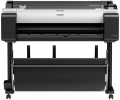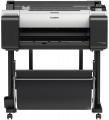Paper size
The paper size the plotter is designed to operate with. Most models use ISO 216 formats, identified by the letter A followed by a digit. These formats include the popular A4, but plotters usually work with larger paper:
- A0+. This marking means that the plotter is able to work with sheets larger than A0 (see below). The A0+ format itself provides a sheet width of 914 mm, however, in this case, support for wider media is usually provided — about 1100 mm (1050 – 1150 mm) in the most modest models of this format ( A0+ 44 ") and 1500 mm or more in the largest ( A0+ ≥ 60")
- A0. Paper of this format has a size of 1189x841 mm.
- A1. Paper size 841x594 mm — in other words, half of the A0 format.
- A2. A sheet of this format is approximately the size of a newspaper spread — 420x594 mm, half the size of A1. Considered relatively small by plotter standards.
- A3. The smallest format found in modern plotters: 297x420 mm, that is, only twice the standard A4 (in other words, with a magazine spread). Used in few desktop models (see Installation) — particularly, textile devices (see Product Type) for printing on T-shirts and other similarly sized clothes.
It is also worth noting that many models are able to work with other sizes. Moreover, we are talking not only about reduced, but also about la
...rger options: the maximum media width (see below) often exceeds the standard paper size.Sheet printing time
Approximate time taken by the plotter to print one sheet.
This indicates for the paper size that the machine was originally designed for (see "Paper Size"). And it is approximate because it is usually given for optimal or almost optimal printing conditions: low quality and resolution, relatively simple images, etc. So the actual print time of the sheet may differ from the claimed one in one direction or another, depending on the operating parameters — starting from the mentioned quality and resolution to the type of media. However, according to the figures indicated in the specs, it is quite possible to evaluate different models and compare them with each other: the difference in the claimed time, usually, will proportionally correspond to the difference in the actual printing speed.
It is also worth noting that this time is usually indicated by the duration of the printing process itself — from the capture of the sheet by the feeder to the output of the completed print from the device. Interruptions inevitably occur between printing individual sheets, so that the total printing time is longer than the printing time of a sheet multiplied by the number of sheets. For example, a device with a time consumption of 36 sec per sheet theoretically should print about 100 sheets per hour (1 h = 3600 s, 3600/36 = 100), but in fact such a plotter usually produces about 70 – 75 sheets in this time.
Media width (max)
The largest width of paper or other media that the plotter can handle. The larger this parameter, the larger the materials that can be printed on the device; however, the dimensions, weight and cost of the plotter also increase markedly due to this.
Dimensions with stand (WxDxH)
The overall dimensions of the floor plotter (see “Placement”), including the stand, in other words, the dimensions of the device in the operative condition (in addition to the stand itself, other equipment, such as trays for printed materials, is taken into account here). This indicator is worth evaluating how much space is needed to install such a plotter.
Weight
The total weight of the plotter is usually listed without ink and paper. You should pay attention to this parameter foremost when choosing desktop models (see "Placement"): modern plotters are quite massive, which puts forward corresponding requirements for stands for them.

